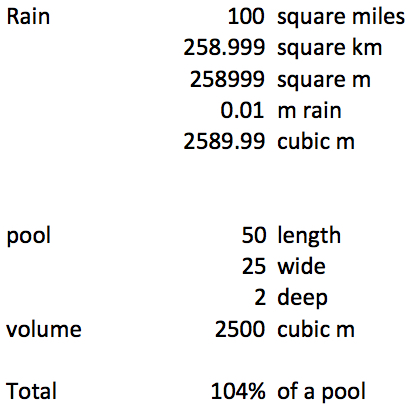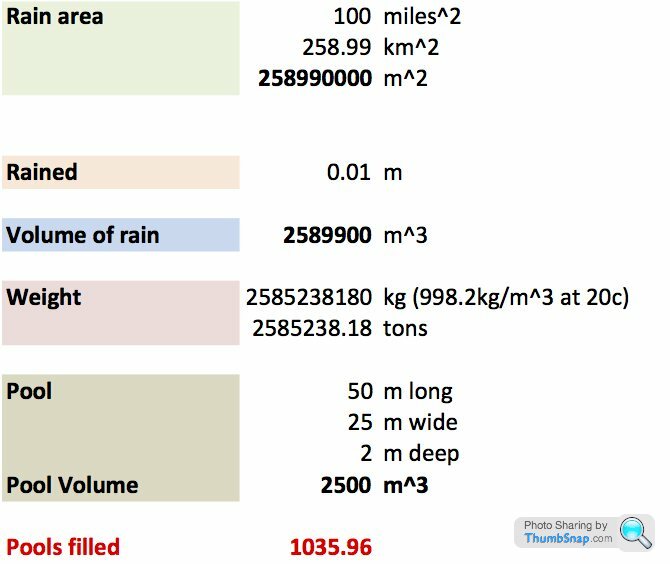What's the weight of all that rain?
Discussion
After a lovely day yesterday I left my car out with the roof down overnight only for it to start raining at about 4am, interior was soaked but there you go.
It got me thinking. If it rained for say 2 hours over an area of 100 square miles, pretty heavy say 10mm how much actual rain would fall?
Would it fill an Olympic swimming pool? How many?
And how much would it weigh?
God knows why but I was just wondering.
Thanks for replies.
It got me thinking. If it rained for say 2 hours over an area of 100 square miles, pretty heavy say 10mm how much actual rain would fall?
Would it fill an Olympic swimming pool? How many?
And how much would it weigh?
God knows why but I was just wondering.
Thanks for replies.
Vaud said:
With apols in advance if I'm wrong but aren't there 1,000,000 sq. metres in 1 sq.km? so shouldn't it be 258,999,000 sq.m (call it 259,000,000)? Which would be 2,590,000 cubic metres (so 2,590,000 tonnes of water and over 1000 pools)....above post got there before me!
Lotus Notes said:
PositronicRay said:
Calculator out time. I think 1sq m is a tonne.
May I suggest that 1m3 is a tonne 
Weight of a rainstorm: https://what-if.xkcd.com/12/
Timsta said:
After reading that I have to say the OP was being a lot more responsible putting his water in swimming pools rather than letting it fall out of the sky together on lots of innocent people.Assuming 100 square miles is taken as 10 miles by 10 miles (as opposed to 100 by 100), then the catchment area is 16.09km x 16.09km = 258.89km². This is 258,890,000m².
Rainfall of 10mm (0.01m) over this catchment would generate 2,588,900m³ of water.
An olympic pool taken as 25m x 50m x 2m will hold 2,500m³ of water, therefore the rainfall above would fill 1,035 pools.
To put these figures into another perspective, 10mm of rainfall over 2 hours is not particularly high. An industry standard 'typical' rainfall event used for fag-packet type calculations would use 50mm per hour.
When undertaking detailed designs of drainage systems the actual rainfall used varies depending on lots of factors, but peak intensities in excess of 200mm per hour are not uncommon.
Rainfall of 10mm (0.01m) over this catchment would generate 2,588,900m³ of water.
An olympic pool taken as 25m x 50m x 2m will hold 2,500m³ of water, therefore the rainfall above would fill 1,035 pools.
To put these figures into another perspective, 10mm of rainfall over 2 hours is not particularly high. An industry standard 'typical' rainfall event used for fag-packet type calculations would use 50mm per hour.
When undertaking detailed designs of drainage systems the actual rainfall used varies depending on lots of factors, but peak intensities in excess of 200mm per hour are not uncommon.
cv01jw said:
Assuming 100 square miles is taken as 10 miles by 10 miles (as opposed to 100 by 100), then the catchment area is 16.09km x 16.09km = 258.89km². This is 258,890,000m².
Rainfall of 10mm (0.01m) over this catchment would generate 2,588,900m³ of water.
An olympic pool taken as 25m x 50m x 2m will hold 2,500m³ of water, therefore the rainfall above would fill 1,035 pools.
To put these figures into another perspective, 10mm of rainfall over 2 hours is not particularly high. An industry standard 'typical' rainfall event used for fag-packet type calculations would use 50mm per hour.
When undertaking detailed designs of drainage systems the actual rainfall used varies depending on lots of factors, but peak intensities in excess of 200mm per hour are not uncommon.
I think your calculations are right BUT.Rainfall of 10mm (0.01m) over this catchment would generate 2,588,900m³ of water.
An olympic pool taken as 25m x 50m x 2m will hold 2,500m³ of water, therefore the rainfall above would fill 1,035 pools.
To put these figures into another perspective, 10mm of rainfall over 2 hours is not particularly high. An industry standard 'typical' rainfall event used for fag-packet type calculations would use 50mm per hour.
When undertaking detailed designs of drainage systems the actual rainfall used varies depending on lots of factors, but peak intensities in excess of 200mm per hour are not uncommon.
50mm of rain in an hour is nearly two inches. London, as an example gets two inches A MONTH!! So in an hour that's an absolute deluge.and far from typical.
The 50mm/hr figure is what is typically quoted (for fag packet calculatoins) as rainfall intensity for a 1 in 30 year 'design' rainfall event; which is the level of protection that the water company regulator requires the industry to provide protection from internal property flooding against. The only trouble is that 1 in 30 year events seem to be happening every few years...
Gassing Station | Science! | Top of Page | What's New | My Stuff




 king big area. My small brain suggests that would fill many swimming pools.
king big area. My small brain suggests that would fill many swimming pools.

